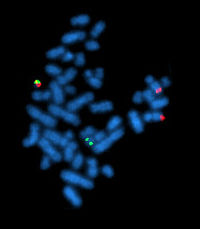
Photo from wikipedia
metamyelocytes and a few eosinophilic cells. Immunohistochemistry (IHC) showed that the tumor was strongly positive for leukocyte common antigen CD45 and pan myeloid marker CD15. Only occasional myeloblasts expressed CD117… Click to show full abstract
metamyelocytes and a few eosinophilic cells. Immunohistochemistry (IHC) showed that the tumor was strongly positive for leukocyte common antigen CD45 and pan myeloid marker CD15. Only occasional myeloblasts expressed CD117 (Fig. 1). This demonstrates that the GS component in this patient comprised of CML in chronic phase with predominantly mature myeloid cells and no significant proportion of myeloblasts. Whole body imaging such as PET CT scan was not done as the disease was already of stage IV in view of the blood involvement and in the absence of clinically detectable lumps or symptoms, would not have changed the management plan. After complete resection of the intracranial GS, the patient was commenced on oral tyrosine kinase inhibitor imatinib at 400 mg once daily dosage, the current standard of care for CML in chronic phase. Patient remains well with normalization of blood counts and no further recurrence of GS. Imatinib will be continued daily indefinitely to maintain the response unless there is further disease progression. CML is a myeloproliferative disease characterized by the presence of the BCR/ABL1 fusion gene. The chronic phase of CML classically presents with neutrophilic leukocytosis and left shift with an increased percentage of myelocytes, metamyelocytes, bands and segmented neutrophils. GS is a non-hepatosplenic extramedullary tumor mass comprised of myeloid leukemia cells. Mouse model studies have shown that AML with MLL gene rearrangements such as MLL/AF10 and MLL/AF9 are predisposed to GS formation with the help of the KRAS oncogene and the cell adhesion molecular receptor Gpr125 [3]. Kobayashi et al. have described the contributory role of a 92 kDa type IV collagenase in the formation of granulocytic sarcoma in a patient with AML [4]. The cytogenetic abnormality t(8;21) has been shown to be associated with a relatively higher incidence of GS in AML. In contrast to these well To the Editor,
Journal Title: Journal of Neuro-Oncology
Year Published: 2017
Link to full text (if available)
Share on Social Media: Sign Up to like & get
recommendations!